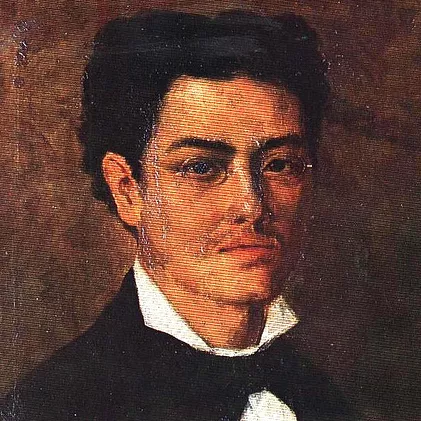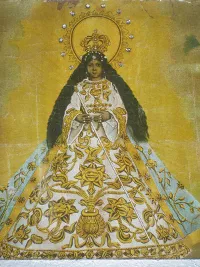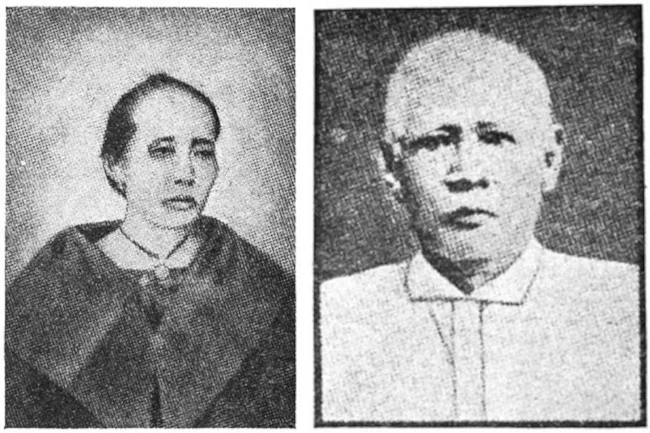In rising to speak I have no fear that you will listen to
me with superciliousness, for you have come here to add to ours your
enthusiasm, the stimulus of youth, and you cannot but be indulgent.
Sympathetic currents pervade the air, bonds of fellowship radiate in all
directions, generous souls listen, and so I do not fear for my humble
personality, nor do I doubt your kindness. Sincere men yourselves, you
seek only sincerity, and from that height, where noble sentiments
prevail, you give no heed to sordid trifles. You survey the whole field,
you weigh the cause and extend your hand to whomsoever like myself,
desires to unite with you in a single thought, in a sole aspiration: the
glorification of genius, the grandeur of the fatherland!
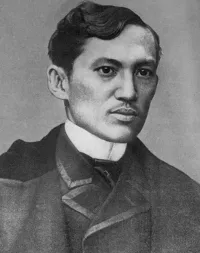
|
|
|
(Dr. Jose P. Rizal)
|
|
Such is, indeed, the reason for this gathering. In the history of
mankind there are names which in themselves signify an achievement-which
call up
reverence and greatness; names which, like magic formulas, invoke
agreeable and pleasant ideas; names which come to form a compact, a
token of peace,
a bond of love among the nations. To such belong the names of Luna and
Hidalgo: their splendor illuminates two extremes of the globe-the Orient
and
the Occident, Spain and the Philippines. As I utter them, I seem to see
two luminous arches that rise from either region to blend there on high,
impelled by the sympathy of a common origin, and from that height to
unite two peoples with eternal bonds; two peoples whom the seas and
space vainly
separate; two peoples among whom do not germinate the seeds of disunion
blindly sown by men and their despotism. Luna and Hidalgo are the pride
of
Spain as of the Philippines-though born in the Philippines, they might
have been born in Spain, for genius has no country; genius bursts forth
everywhere; genius is like light and air, the patrimony of all:
cosmopolitan as space, as life and God.
The Philippines' patriarchal era is passing, the illustrious deeds of
its sons are not circumscribed by the home; the oriental chrysalis is
quitting
its cocoon; the dawn of a broader day is heralded for those regions in
brilliant tints and rosy dawn-hues; and that race, lethargic during the
night
of history while the sun was illuminating other continents, begins to
wake, urged by the electric' shock produced by contact with the
occidental
peoples, and begs for light, life, and the civilization that once might
have been its heritage, thus conforming to the eternal laws of constant
evolution, of transformation, of recurring phenomena, of progress.
This you know well and you glory in it. To you is due the beauty of the
gems that circle the Philippines' crown; she supplied the stones, Europe
the
polish. We all contemplate proudly: you your work; we the inspiration,
the encouragement, the materials furnished.
They imbibed there the poetry of nature-nature grand and terrible in her
cataclysms, in her transformations, in her conflict of forces; nature
sweet,
peaceful and melancholy in her constant manifestation-unchanging; nature
that stamps her seal upon whatsoever she creates or produces. Her sons
carry
it wherever they go. Analyze, if not her characteristics, then her
works; and little as you may know that people, you will see her in
everything
moulding its knowledge, as the soul that everywhere presides, as the
spring of the mechanism, as the substantial form, as the raw material.
It is
imposible not to show what one feels; it is impossible to be one thing
and to do another. Contradictions are apparent only; they are merely
paradoxes.
In El Spoliarium -on that canvas which is not mute-is heard the tumult
of the throng, the cry of slaves, the metallic rattle of the armor on
the
corpses, the sobs of orphans, the hum of prayers, with as much force and
realism as is heard the crash of the thunder amid the roar of the
cataracts,
or the fearful and frightful rumble of the earthquake. The same nature
that conceives such phenomena has also a share in those lines.
|
|
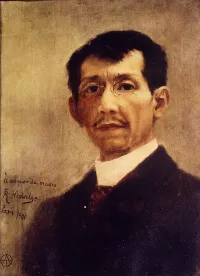
|
|
|
Self portrait, Felix Resurreccion Hidalgo, 1901.
|
On the other hand, in Hidalgo's work there are revealed feelings of the
purest kind; ideal expression of melancholy, beauty, and
weakness-victims of
brute force. And this is because Hidalgo was born beneath the dazzling
azure of that sky, to the murmur of the breezes of her seas, in the
placidity
of her lakes, the poetry of her valleys and the majestic harmony of her
hills and mountains. So in Luna we find the shades, the contrasts, the
fading
lights, the mysterious and the terrible, like an echo of the dark storms
of the tropics, its thunderbolts, and the destructive eruptions of its
volcanoes. So in Hidalgo we find all is light, color, harmony, feeling,
clearness; like the Philippines on moonlit nights, with her horizons
that
invite to meditation and suggest infinity. Yet both of them-although so
different-in appearance, at least, are fundamentally one; just as our
hearts
beat in unison in spite of striking differences. Beth, by depicting from
their palettes the dazzling rays of the tropical sun, transform them
into
rays of unfading glory with which they invest the fatherland. Both
express the spirit of our social, moral and political life; humanity
subjected to
hard trials, humanity unredeemed; reason and aspiration in open fight
with prejudice, fanaticism and injustice; because feeling and opinion
make their
way through the thickest walls, because for them all bodies are porous,
all are transparent; and if the pen fails them and the printed word does
not
come to their aid, then the palette and the brush not only delight the
view but are also eloquent advocates. If the mother teaches her child
her
language in order to understand its joys, its needs, and its woes; so
Spain, like that mother, also teaches her language to Filipinos, in
spite of the
opposition of those purblind pygmies who, sure of the present, are
unable to extend their vision into the future, who do not weigh the
consequences.
Like sickly nurses, corrupted and corrupting, these opponents of
progress pervert the heart of the people. They sow among them the seeds
of discord,
to reap later the harvest, a deadly nightshade of future generations.
But, away with these woes! Peace to the dead, because they are
deadbreath and soul are lacking them; the worms are eating them! Let us
not invoke
their sad remembrance; let us not drag their ghastliness into the midst
of our rejoicing! Happily, brothers are more-generosity and nobility are
innate under the sky of Spain-of this you are all patent proof. You have
unanimously responded, you have cooperated, and you would have done
more, had
more been asked. Seated at our festal board and honoring the illustrious
sons of the Philippines, you also honor Spain, because, as you are well
aware, Spain's boundaries are not the Atlantic or the Bay of Biscay or
the Mediterranean-a shame would it be for water to place a barrier to
her
greatness, her thought. (Spain is there-there where her beneficent
influence i"s exerted; and even though her flag should disappear, there
would
remain her memory-eternal, imperishable. What matters a strip of red and
yellow cloth; what matter the guns and cannon; there where a feeling of
love,
of affection, does not flourish-there where there is no fusion of ideas,
harmony of opinion?
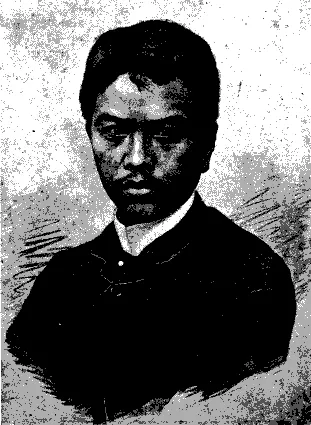
|
|
|
Juan Luna
|
|
Luna and Hidalgo belong to you as much as to us. You love them, you see
in them noble hopes, valuable examples. The Filipino youth of
Europealways
enthusiastic-and some other persons whose hearts remain ever young
through the disinterestedness and enthusiasm that characterize their
actions,
tender Luna a crown, a humble tribute-small indeed compared to our
enthusiasm-but the most spontaneous and freest of all the tributes yet
paid to him.
But the Philippines' gratitude toward her illustrious sons was yet
unsatisfied; and desiring to give free rein to the thoughts that seethe
her mind,
to the feelings that overflow her heart, and to the words that escape
from her lips, we have all come together here at this banquet to mingle
our
vows, to give shape to that mutual understanding between two races which
love and care for each other, united morally, socially and politically
for
the space of four centuries, so that they may form in the future a
single nation in spirit, in duties, in aims, in rights. I drink, then,
to our
artists Luna and Hidalgo, genuine and pure glories of two peoples. I
drink to the persons who have given them aid on the painful road of art!
I drink that the Filipno youth-sacred hope of my fatherland may imitate
such valuable examples; and that the mother Spain, solicitous and
heedful of the welfare of her provinces, may quickly put into practice
the reforms she has so long planned. The furrow is laid out and the land
is not sterile!
And finally, I drink to the happiness of those parents who, deprived of
their sons' affection, from those distant regions follow them with moist
gaze
and throbbing hearts across the seas and distance; sacrificing on the
altar of the common good, the sweet consolations that are so scarce in
the
decline of life — precious and solitary flowers that spring up on the
borders of the tomb.
Source
-
Gems of Philippine oratory; selections representing fourteen centuries
of Philippine thought, carefully compiled from credible sources in
substitution
for the pre-Spanish writings destroyed by missionary zeal, to supplement
the later literature stunted by intolerant religious and political
censorship, and as specimens of the untrammeled present-day utterances,
by Austin Craig, page 34-37, University of Manila, 1924.
